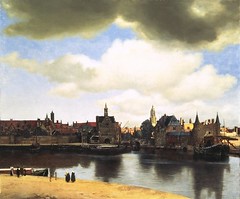Don't miss these museum exhibitions

Johannes Vermeer, "View of Delft" from around 1660.
1. National Gallery of Art - Pride of Place: Dutch Cityscapes of the Golden Age (1600s mostly) at the National Gallery of Art in DC. The text in the exhibition catalog for getting you to think more broadly about cities, how Dutch painters expressed pride in the city through their paintings, how municipal leaders commissioned paintings of their cities for their town halls, the compilation of local histories, even urban tourism in the late 1600s.
Reviews of this exhibit have appeared in the New York Times, "'Pride of Place - Dutch Cityscapes of the Golden Age ...," the Washington Post, "The 'Golden' Compass: Dutch Cityscapes Point to Liveliest of Details" and the Washington Times, "Civic pride motivated Dutch artists," among others.
2. Now that the National Museum of American History is open again, if you haven't had a chance to see the America on the Move Transportation exhibit, now is the time. Until the end (from the 1970s to the present), when it feels like curatorial energy dissipated, it is an excellent explication of how mobility and improvements in transportation technology shape land use.

Exhibits are a great way to get out of your everyday surroundings, and think about places in different ways, with the benefit of broader perspectives. (The themes that curators use to organize exhibits are usually provocative and interesting and spur different ways of thinking about your day to day urban experiences.)
Labels: arts-culture, museums, urban design/placemaking, urban history



0 Comments:
Post a Comment
<< Home